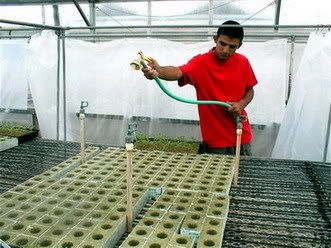There are many choices of energy sources, such as natural gas, propane, fuel oil and electricity. Many early hydroponic growers did not consider cost differences between the types of energy. Many used natural gas and fuel oil. Coal was once used but air pollution standards and regulations make the use of this fuel prohibitively expensive.
There is new interest today in lighting greenhouses with high intensity-discharge lamps. Both the capital and operating cost of such systems are extremely high and will not, in the foreseeable future, permit competition with winter greenhouse vegetables grown in highlight regions. An exception may be in Quebec, Canada, where the electrical rates are extremely low.

Water quality has become a major concern of greenhouse growers, especially where large amounts of water are applied to a restricted volume of growing medium. Plant growth is affected by the interaction of the dissolved chemical elements in the water supply, the chemical properties of the growing medium to which the water is applied, and the fertility program employed.
In selecting a greenhouse site, a grower must be aware of several chemical properties that might cause problems for greenhouse growers: pH, alkalinity, soluble salts, calcium, magnesium, boron, fluoride, chloride, sulfates, sodium, carbonate, and iron. The cleaner the water, the greater the opportunity to achieve maximum yields. The water designated for use in a greenhouse must be analyzed for agricultural suitability during greenhouse site selection.
There is new interest today in lighting greenhouses with high intensity-discharge lamps. Both the capital and operating cost of such systems are extremely high and will not, in the foreseeable future, permit competition with winter greenhouse vegetables grown in highlight regions. An exception may be in Quebec, Canada, where the electrical rates are extremely low.

Water quality has become a major concern of greenhouse growers, especially where large amounts of water are applied to a restricted volume of growing medium. Plant growth is affected by the interaction of the dissolved chemical elements in the water supply, the chemical properties of the growing medium to which the water is applied, and the fertility program employed.
In selecting a greenhouse site, a grower must be aware of several chemical properties that might cause problems for greenhouse growers: pH, alkalinity, soluble salts, calcium, magnesium, boron, fluoride, chloride, sulfates, sodium, carbonate, and iron. The cleaner the water, the greater the opportunity to achieve maximum yields. The water designated for use in a greenhouse must be analyzed for agricultural suitability during greenhouse site selection.







